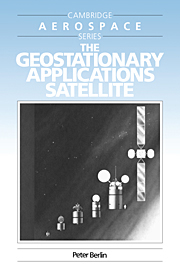Book contents
- Frontmatter
- Contents
- Dedication
- Preface
- List of Acronyms
- 1 Launch vehicles
- 2 The transfer orbit
- 3 The geostationary orbit
- 4 The satellite environment
- 5 Structures
- 6 Mechanisms
- 7 Thermal control
- 8 Power supply and conditioning
- 9 Propulsion and orbit control
- 10 Attitude stabilization, measurement and control
- 11 Telemetry, tracking and command (TT&C)
- 12 Communications payload
- 13 Meteorological payload
- 14 Product assurance
- 15 Spacecraft development and testing
- Index
9 - Propulsion and orbit control
Published online by Cambridge University Press: 02 February 2010
- Frontmatter
- Contents
- Dedication
- Preface
- List of Acronyms
- 1 Launch vehicles
- 2 The transfer orbit
- 3 The geostationary orbit
- 4 The satellite environment
- 5 Structures
- 6 Mechanisms
- 7 Thermal control
- 8 Power supply and conditioning
- 9 Propulsion and orbit control
- 10 Attitude stabilization, measurement and control
- 11 Telemetry, tracking and command (TT&C)
- 12 Communications payload
- 13 Meteorological payload
- 14 Product assurance
- 15 Spacecraft development and testing
- Index
Summary
Introduction
In Chapter 1 we looked at propulsion and orbit acquisition in the context of launch vehicles. We established that only one vehicle (Proton) is capable of routinely injecting satellite payloads directly into geostationary orbit, and that passengers onboard any of the other vehicles had to be equipped with rocket engines of their own to accomplish the final leg of the voyage. In Chapter 3 we examined the causes of north-south and east-west drift of a geostationary satellite around its nominal sub-satellite point. We also suggested strategies for drift correction using thrusters. The design and use of these onboard propulsion devices is the subject of the present chapter.
Propulsion
Bipropellant Subsystem Architecture
Figure 9.1 shows the design of a modern bipropellant propulsion subsystem. The MMH fuel and the N2O4 oxidizer are stored in separate tanks. Pipes run from the tanks to a large thruster and to 12 smaller thrusters. Each thruster has a valve to admit propellants. When the fuel and the oxidizer mix in the thrust chambers, they ignite spontaneously. The combustion generates thrust forces. The large thruster is an apogee kick motor (AKM), while the smaller thrusters are used for orbit and attitude control.
The round tank at the top of the figure contains helium gas to pressurize the fuel and oxidizer tanks. Pressurization fulfils the same function as turbopumps in launch vehicle engines, namely to feed propellant to the thrusters at a controlled rate.
- Type
- Chapter
- Information
- The Geostationary Applications Satellite , pp. 105 - 120Publisher: Cambridge University PressPrint publication year: 1988
- 1
- Cited by



